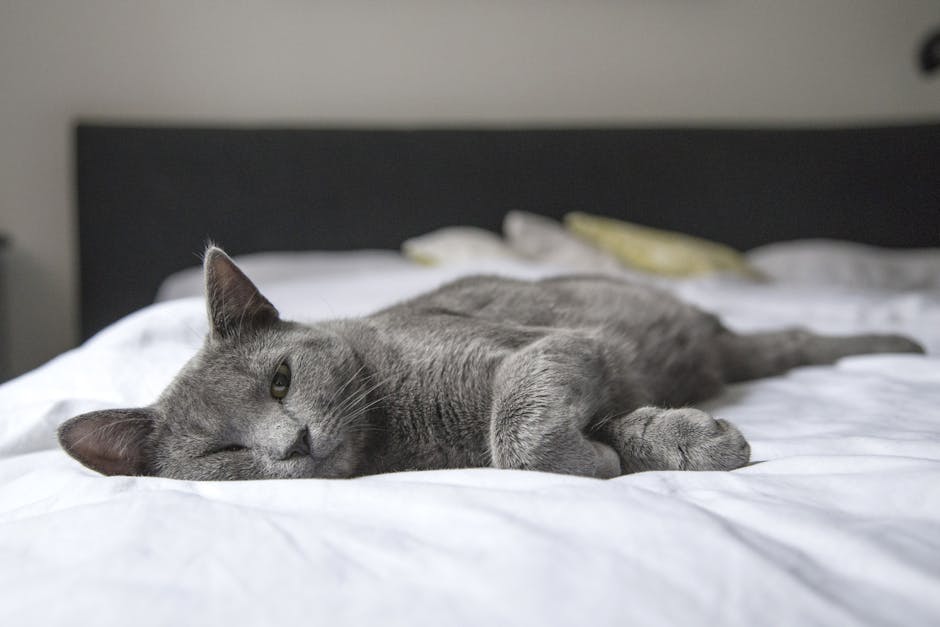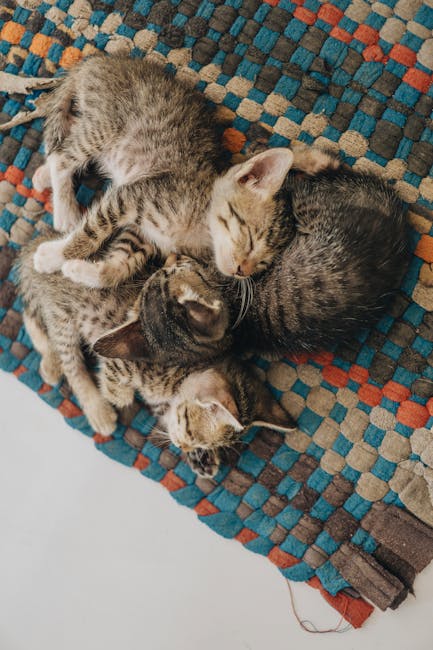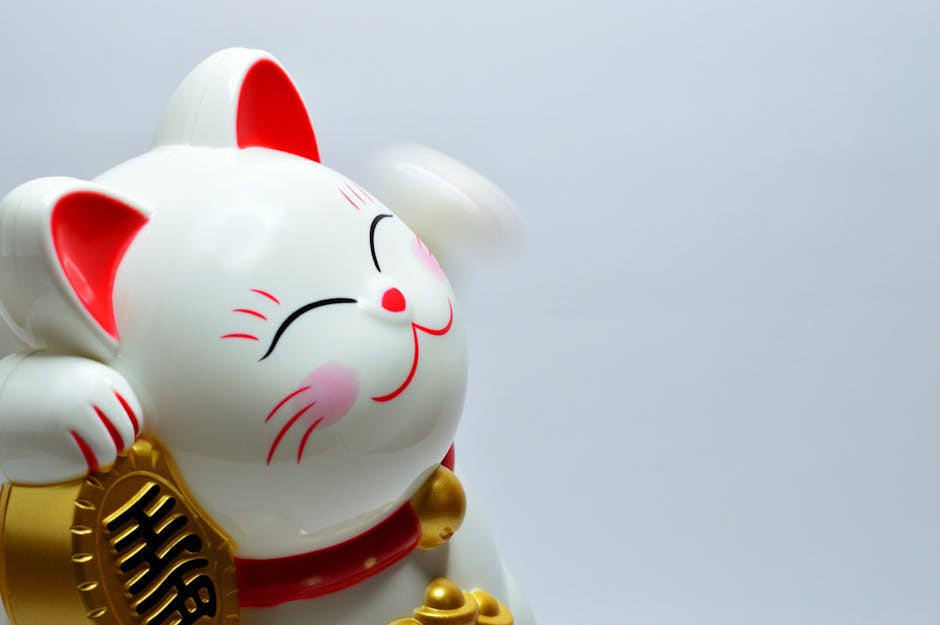
Introduction
Importance of Understanding Cat Napping Habits
Cats are remarkable creatures, exhibiting an exceptional ability to nap throughout the day. Unlike humans, who tend to adhere to a more structured sleep routine, cats embrace the art of napping with an effortless grace that many of us can learn from. Understanding these napping habits is not just an intriguing aspect of feline behavior; it has significant implications for how we care for our furry companions.
The Nature of Cat Napping
Cats can nap in any position and at any time, demonstrating remarkable versatility in their resting habits. This polyphasic sleep pattern, characterized by multiple short bouts of sleep rather than a single long sleep period, keeps them alert and ready for action. Recognizing this unique approach to rest can help cat owners create a more nurturing environment for their pets.
Why Cat Napping Matters:
- Health and Well-being:
Adequate sleep is vital for a cat’s physical health and emotional well-being. The benefits of cat naps include:
- Improved immune function
- Enhanced cognitive abilities
- Reduction in stress levels
- Understanding Their Behavior:
By observing their napping habits, cat owners can gain insights into their cats’ overall health and mood. Such understanding can unveil important signals related to stress or illness, allowing for timely interventions if necessary.
- Enhancing Human-Cat Relationships:
When owners comprehend the importance of naps in their cats’ lives, they can better appreciate their need for rest and relaxation. This knowledge fosters a stronger bond, as owners learn to respect their feline friend’s sleep schedule and needs.
- Learning from Cats:
The art of the cat nap serves as a gentle reminder for us to prioritize rest in our own lives. In our fast-paced world, we often forget the value of taking a break to recharge. Observing how your cat embraces rest can inspire you to adopt a more balanced approach to your well-being.
In conclusion, understanding your cat’s napping habits facilitates better care and deepens your bond, paving the way for a happier and healthier life for your feline companion. As we explore the world of cat naps, we uncover the many facets of their sleep cycles and the subtle signals they communicate through their resting behavior.

Cat Sleep Cycles
REM Sleep in Cats
Cats experience distinct sleep phases, similar to humans, including REM (Rapid Eye Movement) sleep. This stage is particularly vital for cognitive and emotional health. During REM sleep, your cat’s brain is highly active, displaying rapid eye movements beneath their eyelids.
Key Characteristics of REM Sleep:
- Duration: In cats, REM sleep occurs in shorter bursts, typically lasting only about 5 minutes at a time.
- Significance: This phase is crucial for memory consolidation and processing experiences, which is why you may notice your cat twitching or making small movements during this stage. These involuntary actions may indicate they are dreaming.
- Frequency: Cats may enter REM sleep multiple times a day, contributing to their overall sleep needs and allowing for physical and mental rejuvenation.
Understanding REM sleep can help cat owners recognize when their pets are in a vulnerable state, making it important to provide a safe and quiet environment during these periods.
Non-REM Sleep in Cats
Non-REM sleep consists of deeper and lighter sleep phases, which play a significant role in overall rest and recovery. This stage is further divided into light sleep and deep sleep, essential for a cat’s well-being.
Highlights of Non-REM Sleep:
- Phases of Non-REM Sleep:
- Light Sleep (15-30 minutes): This is the stage where cats are still somewhat aware of their surroundings. They may wake up easily, which is a survival mechanism rooted in their evolutionary history as predators.
- Deep Sleep: In this phase, cats enter a more restorative state, though these periods are relatively short compared to humans, contributing to their unique sleeping pattern.
- Health Benefits:
- Adequate non-REM sleep supports immune function, muscle repair, and overall health. It allows cats to recharge their energy and maintain physical agility.
- Like REM sleep, non-REM sleep helps in emotional regulation and can reduce stress levels.
Understanding the intricacies of your cat’s sleep cycles can enhance your ability to care for them effectively. By recognizing when they are in each sleep phase, cat owners can create a supportive environment that fosters optimal rest, making it easier for their feline companions to thrive both physically and emotionally.

Factors Affecting Cat Napping
Environmental Factors
The environment plays a significant role in influencing a cat’s napping habits. Cats are highly sensitive to their surroundings, and various environmental cues can dictate when and where they choose to sleep.
Key Environmental Considerations:
- Comfortable Spaces:
- Cats prefer soft, cozy spots for napping. Access to comfortable bedding or warm surfaces is essential for promoting restful sleep.
- Elevated spaces, such as cat trees or shelves, offer a sense of security and allow them to observe their surroundings, which can enhance their comfort during rest.
- Quiet Areas:
- A peaceful environment is crucial for uninterrupted sleep. Loud noises or frequent disruptions can affect their ability to relax fully.
- Creating designated quiet zones in the home can encourage cats to nap undisturbed.
- Lighting Conditions:
- Natural light affects a cat’s sleep cycle. Cats are instinctively drawn to sunny spots and prefer bright areas during their lighter resting phases.
- Conversely, too much artificial light can disrupt their natural circadian rhythm, influencing their sleep patterns.
By considering these environmental factors and adjusting the home setting, cat owners can create a more conducive atmosphere for their feline friends’ napping needs.
Health and Age Influences
A cat’s health and age are critical determinants of their sleeping behavior. Changes in these areas can significantly impact their overall sleep patterns and duration.
Factors to Consider:
- Age:
- Kittens typically require more sleep, often napping up to 20 hours a day due to their rapid growth and development.
- Aging cats may also sleep more as they require additional rest to support their declining energy levels and health concerns.
- Health Issues:
- Cats suffering from health problems, such as arthritis, infections, or dental issues, may experience disrupted sleep. Discomfort can lead to increased restlessness and a tendency to seek out specific positions for relief.
- Conversely, if a cat is unwell, their sleeping patterns may change dramatically. Increased lethargy may indicate underlying health issues requiring veterinary attention.
- Stress and Anxiety:
- Environmental stressors, such as changes in the household, new pets, or loud noises, can lead to anxious behavior and affect a cat’s ability to nap comfortably.
Understanding these factors can help cat owners provide optimal care for their pets, ensuring their napping habits align with their health and lifestyle needs. By fostering an accommodating environment, owners can support their feline friends in achieving restorative sleep and overall well-being.

Common Cat Napping Positions
Curling Up
One of the most common and endearing napping positions for cats is curling up. When cats curl into a ball, they are not merely seeking warmth; this posture also serves multiple biological and psychological purposes.
Key Aspects of Curling Up:
- Safety and Security:
- By curling up, cats are instinctively protecting their vulnerable body parts, such as their belly and throat, from potential threats.
- This position allows them to feel more enclosed and safe, which can reduce stress during sleep.
- Heat Conservation:
- Cats have a higher preference for warmer environments, and curling up helps them conserve body heat, making it a favorite resting position during cooler temperatures.
- Alertness While Resting:
- Despite appearing to be in a deep slumber, this position allows cats to remain alert. They can quickly spring into action if a potential threat arises while still enjoying a short nap.
Observing your cat in this position can also provide insights into their mood. A cat that frequently curls up in safe spaces likely feels secure and comfortable in their environment.
Stretching Out
On the flip side, when cats choose to stretch out, it conveys a completely different message about their comfort level and state of mind.
Key Characteristics of Stretching Out:
- Relaxation and Trust:
- A cat that stretches out, exposing its belly and legs, is demonstrating a high level of trust in its surroundings. This open position indicates comfort and contentment, showing they feel safe enough to let their guard down.
- Stretching is also a signal that the cat is experiencing good rest and isn’t worried about immediate threats.
- Body Language:
- Cats may stretch out fully, sprawling on their side or back, in an attempt to cool down. This behavior is common in warmer environments, as it allows for greater air exposure to regulate body temperature.
- Additionally, stretching can serve as a form of exercise, helping to keep muscles limber and prepared for quick movements when needed.
Recognizing the significance of these napping positions can help cat owners assess their pets’ emotional and physical state. Sudden changes in their sleeping posture or preference for certain positions may indicate underlying health concerns or shifts in their overall well-being. By understanding their napping habits, owners can foster a better environment and ensure their furry friends remain happy and healthy.

Creating a Comfortable Sleeping Environment for Your Cat
Ideal Bedding Options
Providing the right bedding is essential for ensuring that your cat can enjoy restful sleep. Cats sleep anywhere from 15 to 18 hours a day, so creating a cozy, safe, and supportive space is crucial.
Key Bedding Considerations:
- Soft and Cozy Materials:
- Look for bedding made from soft, plush fabrics that can provide warmth and comfort. Cats often prefer materials such as fleece or microfiber.
- Consider options like cat beds, blankets, or even a designated spot on the couch where they can curl up without disturbances.
- Supportive Structures:
- Orthopedic beds can be beneficial for older cats or those with joint pain. These beds provide extra support for their bodies, helping to ease discomfort.
- Raised or elevated beds allow for a secure vantage point, making cats feel safe while resting.
- Location Matters:
- Place bedding in quiet, low-traffic areas where your cat can nap undisturbed. Cats appreciate privacy and will feel more comfortable in secluded spots, especially if they are curl-up nappers.
By providing suitable bedding options, you encourage your cat to enjoy quality sleep and maintain their overall well-being.
Temperature and Lighting Considerations
In addition to comfortable bedding, the temperature and lighting in your home can significantly affect your cat’s ability to sleep well.
Optimal Temperature:
- Warmth is Key:
- Cats prefer warmer environments, so aim for a temperature range between 70-75°F (21-24°C). If your home tends to be colder, consider using blankets or heated pads to enhance warmth during their naps.
- Always ensure there’s good airflow in the area. While cats enjoy warmth, they can also become overheated in excessively warm places.
Lighting Conditions:
- Natural Light Preferences:
- Cats naturally gravitate towards sunny spots during the day. Providing access to areas with natural light allows your cat to bask and enjoy the warmth.
- However, ensure there are shaded spots available for them to retreat to if they feel too warm.
- Controlled Lighting at Night:
- Reduce artificial lighting during nighttime hours to create a peaceful environment conducive to sleep. Many cats prefer dimly lit spaces for resting, as this mimics their natural instincts.
By fine-tuning both bedding options and environmental settings, cat owners can greatly enhance their pets’ sleep experiences. Comfort, temperature, and lighting go hand in hand to create a serene atmosphere where your feline companion can truly relax and recharge.

Interpreting Your Cat’s Sleeping Behavior
Signs of Stress or Illness
Observing your cat’s napping habits can reveal much about their emotional and physical well-being. While cats are known for their relaxed demeanor, any significant changes in their sleeping behavior may indicate stress or health issues.
Key Signs to Watch For:
- Increased Lethargy:
- If your cat is sleeping more than usual—beyond the typical 15-18 hours—this could be a red flag. Extended periods of lethargy may indicate illness or discomfort.
- Restlessness:
- Cats that seem unable to settle down, constantly shifting positions or getting up frequently, might be experiencing stress or pain. Watch for signs of discomfort during their light resting phases.
- Changes in Sleeping Locations:
- A sudden preference for hiding or unusual napping spots could suggest fear or anxiety. Cats often seek out secluded areas when feeling threatened or unwell.
- Vocalization During Sleep:
- Purring, growling, or other vocalizations while napping can indicate distress. If these sounds are not typical for your cat, it may signify underlying issues that need attention.
If you notice these signs persisting, it’s crucial to consult with a veterinarian to rule out any medical conditions and ensure your feline friend is receiving proper care.
Contentment Indicators
In contrast, a cat’s sleeping behavior can also indicate a sense of security and happiness. Understanding these indicators can enhance your bond with your pet and assure you that they are enjoying a fulfilling life.
Signs of a Content Cat:
- Relaxed Posture:
- Cats that sleep with their bodies fully extended, limbs sprawled out, or rolling onto their backs are likely feeling comfortable and secure. This open stance shows trust in their environment.
- Gentle Breathing:
- A calm, rhythmic breathing pattern during sleep often signifies relaxation and contentment. If your cat is peacefully dozing without twitching or stirring too often, they are likely in a happy state.
- Snoozing in Sunlight:
- Cats love soaking up the sun, and opting for a nap in sunny spots indicates they are both comfortable and satisfied. This behavior showcases their instinctive need for warmth, paired with a sense of safety.
- Purring:
- Soft purring while napping often indicates a relaxed and happy cat. This comforting sound suggests your feline is at ease and feels content in their surroundings.
Interpreting these behaviors correctly can help cat owners better respond to their pets’ needs. Recognizing both signs of stress or illness and indicators of contentment contributes significantly to fostering a supportive and caring environment for your feline friend. By paying attention to their sleeping patterns, you ensure they lead a happy, healthy life.

Conclusion
Enhancing Your Relationship Through Understanding Cat Napping
Understanding your cat’s napping habits can significantly enhance the bond you share with your furry friend. By observing their sleeping behaviors, you gain insights into their emotional and physical health, allowing you to better cater to their needs.
Why Understanding Matters:
- Communication of Needs:
- Cats communicate a great deal through their sleeping positions and patterns. By recognizing signs of stress or contentment, you can adjust your care approach, ensuring your cat feels happy and safe.
- Whether they prefer curling up in a cozy nook or sprawling out in a sunbeam, knowing their preferences helps you provide the ideal sleeping environment.
- Health Monitoring:
- Changes in sleep behavior can often be indicative of underlying health issues. For example, increased lethargy might suggest a medical problem that requires immediate attention.
- Regular observation of your cat’s habits enables early detection of potential health issues, leading to timely veterinary consultations and interventions.
- Encouraging Natural Behaviors:
- By creating a comfortable and enriching environment, you promote your cat’s instinctual behaviors, allowing them to engage in natural sleeping habits. Providing diverse sleeping spots—like a warm bed, sunny window ledge, or secure hideaway—can stimulate their desire to explore and rest comfortably.
- Learning from Their Approach to Rest:
- Cats excel at taking the necessary breaks to rest when needed, an important lesson for humans as well. Observing how they embrace relaxation can encourage us to appreciate our own need for rest, reducing stress and promoting better mental health.
- Adopting small lessons from your cat’s napping habits, such as listening to your body and taking breaks, can improve your own well-being and overall quality of life.
By engaging in a deeper understanding of your cat’s napping behavior, you can create a nurturing atmosphere that fosters both comfort and health. This not only strengthens your relationship but also enriches the life of your feline companion. Ultimately, the art of the cat nap serves as a reminder of the importance of rest and relaxation, both for our furry friends and ourselves. Your dedication to understanding their needs will lead to a happier, healthier life for both you and your beloved pet.

